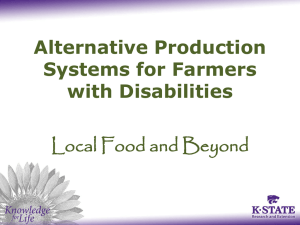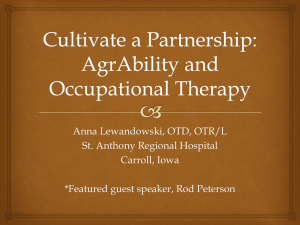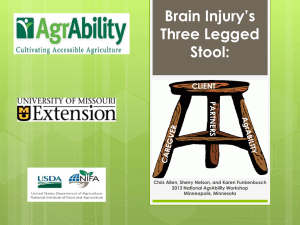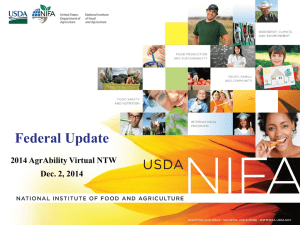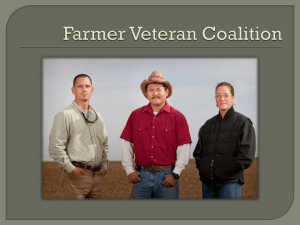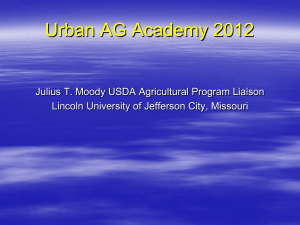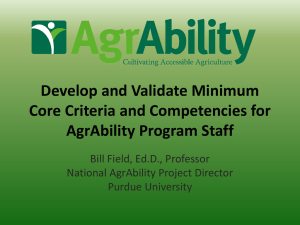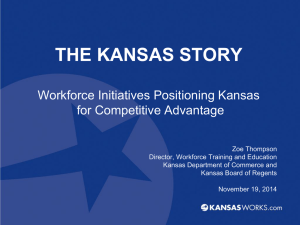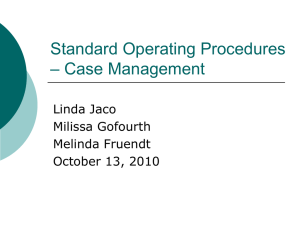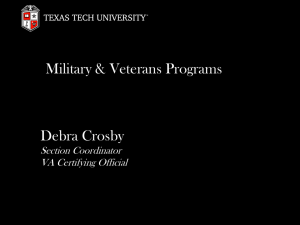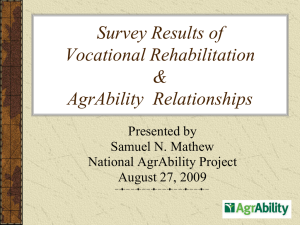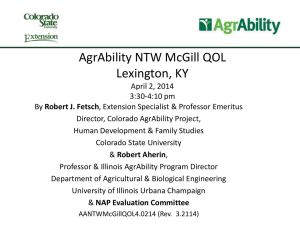Presentation file - National AgrAbility Project
advertisement
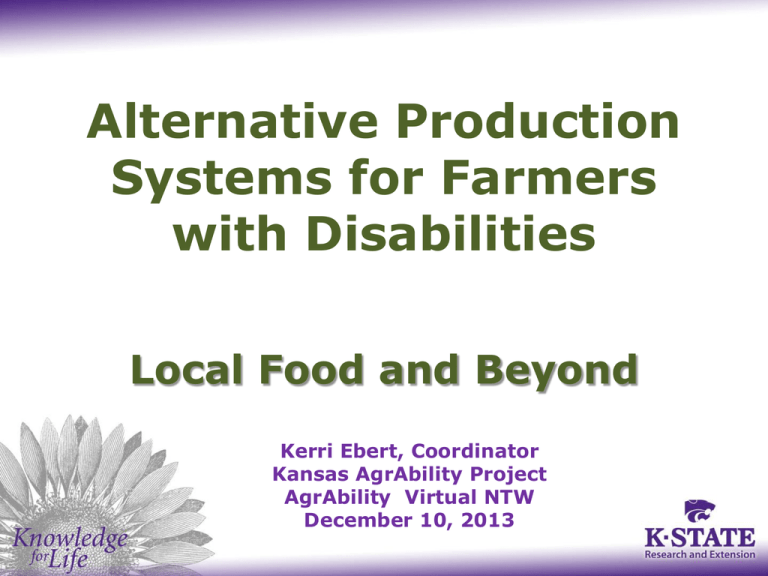
Alternative Production Systems for Farmers with Disabilities Local Food and Beyond Kerri Ebert, Coordinator Kansas AgrAbility Project AgrAbility Virtual NTW December 10, 2013 Basic Webinar Instructions • Need speakers or headphones to hear the presentation. No phone connection. • Meeting > Manage My Settings > My Connection Speed – Dial-up not recommended • Questions about presentation – Type into chat window and hit return. – During the Q & A period, if you have a web cam/microphone, click the “Raise Hand” icon to indicate that you have a question • We will activate your microphone Basic Webinar Instructions • 4 quick survey questions • Session recorded and archived at http://agrability.org/OnlineTraining/virtualntw/index.cfm along with resource materials • Problems: use chat window or email agrability@agrability.org Known Webinar Issues • Echo – Check to see if you are logged in twice • Disconnection with presenters – Hang on – we’ll reconnect as soon as possible • Disconnection with participants – Log in again • AgrAbility: USDA-sponsored program that assists farmers, ranchers, and other agricultural workers with disabilities. – Partners land grant universities with disability services organizations – Currently 20 projects covering 22 states – National AgrAbility Project: Led by Purdue’s Breaking New Ground Resource Center. Partners include: • • • • Goodwill of the Finger Lakes The Arthritis Foundation, Heartland Region The University of Illinois at Urbana-Champaign Colorado State University – More information available at www.agrability.org Alternative Production Systems for Farmers with Disabilities Local Food and Beyond Kerri Ebert, Coordinator Kansas AgrAbility Project AgrAbility Virtual NTW December 10, 2013 Learning Objectives 1. Learn about small scale and alternative ag production methods 2. See examples of small scale and alternative production methods used in Kansas 3. Discuss possibilities for your states and identify resources Why this topic at this time? • United States Department of Agriculture Economic Research Service (USDA ERS) Report – January 2013 – Food Insecurity Among Households With Working-Age Adults With Disabilities • There is a strong association between disability and food insecurity • 33.5% of households with an adult who is not in the workforce because of disability are food insecure Why this topic at this time? • Veterans – Gulf Wars I and II have resulted in 1.6 million veterans who fought for America and survived. – Approximately 10% of post-9/11 veterans are officially classified as disabled. – About 45% of veterans are seeking disability benefits from the Veterans Affairs (VA) Department. – 3.5 million = total number of veterans with a serviceconnected disability – The unemployment rate for Gulf War I and II veterans hovers around 9%; some sources put it closer to 20% Total population of veterans is >21.5 million; 1.6 million of whom are female. Source: U.S. Department of Veterans Affairs Why this topic at this time? Enthusiasm for farming among young adults (college age) and older Americans who “want” to farm. We Need More Farmers! • Local Food Movement – Consumer driven – Opens new market opportunities for farmers – Increases demand for new farmers • Self Employment can be an excellent opportunity for people with disabilities • Farming can be therapeutic for returning veterans In Kansas we don’t have enough fresh produce to meet consumer demand at our largest farmer’s markets. Small Scale Ag & Alternative Crops • The Worldwatch Institute*: A move from industrial farming towards local food projects is our healthiest, most sustainable choice. • Food waste – another reason for more local growers. Conservative estimate of food waste in the U.S. is ¼ of all food produced. – – – – Prepared and not eaten Damaged in transport Spoilage Unsold fresh produce in stores *State of the World Report 2011: Innovations that Nourish the Planet We Need More Farmers to Grow Fresh Produce! • Can we (AgrAbility) help bridge the gaps between: – Americans with disabilities and food security – AgrAbility customers and increased local food demand – Needs of our returning veterans; many of whom were raised in rural areas. ? YES, WE CAN In fact, we’ve already started. So let’s look at some types of alternative food production and niche markets that can and do work for people with disabilities. Because small-scale farming is an excellent self employment option and doesn’t take a huge start-up investment! Small Scale/Alternative Options • Traditional Fruits – Tree fruits (apples, peaches, pears, cherries) – Bramble fruits (blackberries, raspberries) – Small fruits (blueberries, strawberries, grapes) • Specialty Fruits – – – – Figs (growing zones 6-9) Elderberries (growing zones 4-8) Currants (growing zones 3-7) Kiwi (growing zones 5-8) • Herbs – culinary and medicinal Small Scale/Alternative Options • Traditional Vegetables – Tomatoes – Peppers – Squash • Specialty Vegetables – Miniature and/or colored anything • Yellow or purple carrots; 8-ball zucchini; yellow beets – Ethnic vegetables – varies by location and local ethnic population • Bok Choy and other Choys • Chinese cabbage • Specialty peppers Source: USDA, Alternative Crops & Enterprises for Small Farm Diversification Small Scale/Alternative Options • Animals (protein) – Game-related: buffalo, deer, fish bait, pheasant, quail – Minor Breeds: goats, sheep, rabbits – Poultry: chickens, ducks, geese – Aquaculture: tilapia, shrimp Conventional OR Organic? It’s up to the producer and the consumer Source: USDA, Alternative Crops & Enterprises for Small Farm Diversification Let’s take a virtual farm tour for our virtual training workshop Examples – Niche Markets Green beans in north central Kansas Source: Kansas SARE Examples – Niche Markets Chestnuts in northeast Kansas Source: Kansas SARE Examples – Niche Markets Poultry Left: rotationally grazed, heritage bred turkeys Right: Brooder house for chickens made from pickup toppers and straw bales Source: Kansas AgrAbility Project Examples Mineral tubs and 5-gallon buckets as raised beds with a small hoop houses for season extension Source: Kansas AgrAbility Project Examples Garden plot donated to local ILC by a farm implement dealer. Source: Kansas AgrAbility Project Examples Garden plots on vacant lots in Kansas City, Kansas. Lower left photo is experimental “slot farming” technique; uses and edger to create slot for seed and existing crab grass as the mulch. Source: Kansas SARE Examples Recycled totes as raised beds; even winterized raised beds with the hoop structure. Source: Kansas AgrAbility Project Examples Another example of a raised bed. Source: Kansas AgrAbility Project Examples Minimal equipment investment: PVC / 2X4 frame, recycled billboard used as a cover. Source: Kansas SARE Examples High tunnels offer high potential for planting densely. Notice how much is planted in such a small area and the use of containers with in-ground planting. Source: Kansas SARE What’s a Hoop House? High tunnels, or hoop houses, are unheated greenhouses that can help extend the growing season and improve the profitability and productivity of their farms. High tunnels are also an integral part of local food production systems in many parts of the United States. They aid fruit and vegetable crop production by extending the cropping season, providing protection from the elements (wind, storms, heat, etc.), and result in a more-stable production system that poses less risk of crop failure. High tunnels come in many different shapes, sizes, and structures. Many 4-season tunnels are as small as 1000 sq ft for, and 3-season tunnels (plastic is removed during winter) can span ranges up to 20+ acres. Examples Hoop houses as therapy – constructing and growing -- Fort Riley, Kansas, mTBI Clinic. http://www.youtube.com/watch?v=R1mL8G0iRWc&feature=youtu.be Source: Kansas AgrAbility Project Resources United States Department of Agriculture (USDA) – www.usda.gov – Alternative Farming Systems Information Center, http://afsic.nal.usda.gov – National Agricultural Library • Alternative Crops & Enterprises for Small Farm Diversification, http://www.nal.usda.gov/afsic/pubs/altlist.shtml – Start2Farm, http://start2farm.gov/ – Farm Service Agency, http://www.fsa.usda.gov Resources For Veterans – Information for Veterans • http://www.outreach.usda.gov/veterans.htm – Farmer Veteran Coalition, http://www.farmvetco.org/ • Veteran Careers in Agriculture: A Resource Guide, AgrAbility featured on Page 31 – Combat Boots to Cowboy Boots, http://ncta.unl.edu/ • Nebraska College of Technical Agriculture, Curtis, NE – 100 Beef Cow Advantage Program – 100 Acre Farm Advantage Program Resources • ATTRA – National Sustainable Agriculture Information Center – https://attra.ncat.org/ • Sustainable Agriculture Research and Education (SARE) – http://www.sare.org/ • eXtension (virtual Extension office) – http://www.extension.org/ Local Resources • USDA County Offices – Farm Service Agency (FSA) – Rural Development (RD) – Natural Resources Conservation Service (NRCS) • County/Area Extension Offices – Master Gardener Programs – Community Garden Program – Farmers Market Information Local Resources • State Department of Agriculture • State SARE Coordinator • State Commission/Department of Veterans Affairs • Small Business Development Centers • State Farm Organizations – Farmers Union – Small / Sustainable Farmers Associations Kerri Ebert Kansas AgrAbility Project kebert@k-state.edu http://agrability.bae.ksu.edu
